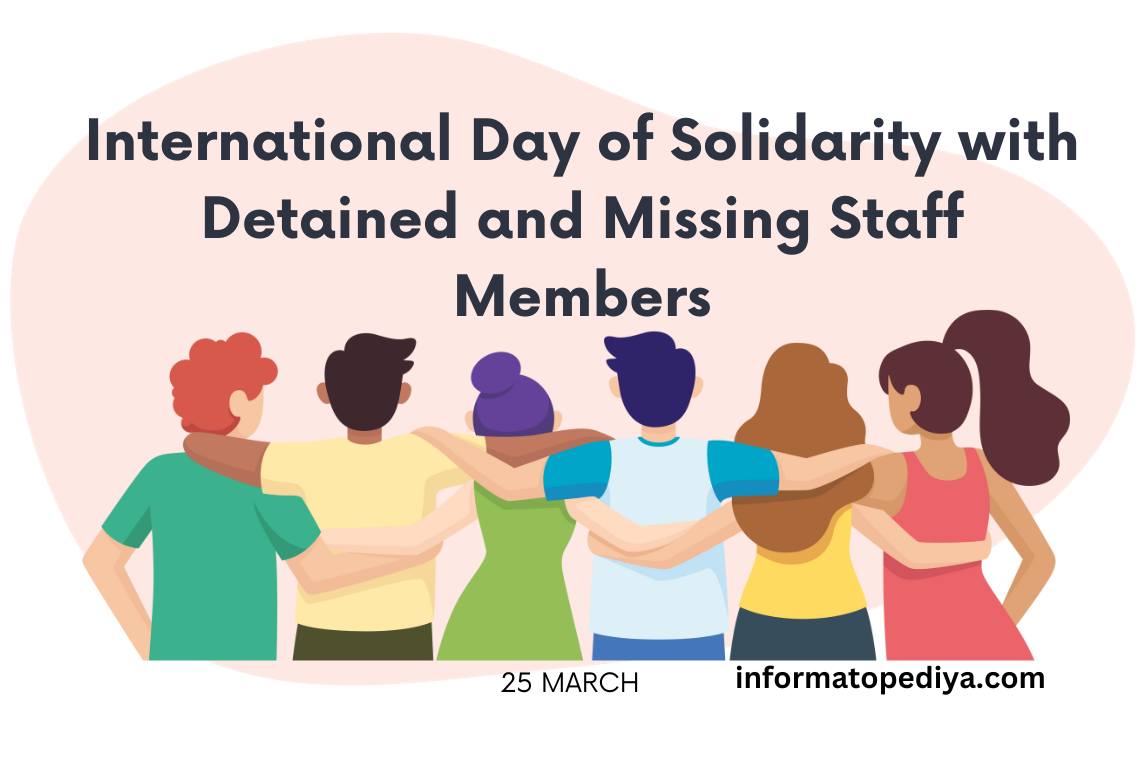
International Day of Solidarity with Detained and Missing Staff Members: Honoring Courage and Resilience
Table of Contents
Introduction:
The International Day of Solidarity with Detained and Missing Staff Members, found on March 25th each year, is a poignant event that recognizes the sacrifices and demanding situations faced with the aid of individuals running in humanitarian and peacekeeping roles. This day serves as a solemn reminder of the devoted professionals who have been detained, gone missing, or confronted threats while also wearing out their responsibilities in battle zones and areas of crisis. Organized with the aid of the United Nations (UN), this present day targets to elevate consciousness approximately the importance of the safety and protection of humanitarian employees and to mobilize support for folks that preserve to paintings in hard environments. In this comprehensive article, we are able to explore the origins and importance of the International Day of Solidarity, highlight the dangers faced by humanitarian workers, and underscore the significance of collective efforts to ensure their safety and well-being.
The Origins and Significance of the International Day of Solidarity:
1. UN General Assembly Resolution:
The International Day of Solidarity with Detained and Missing Staff Members was established by the United Nations General Assembly through Resolution A/RES/64/129. The decision was adopted on December 16, 2009, and specified March 25th as the day to commemorate the lives and contributions of humanitarian workers who’ve confronted adversity within the direction of their service.
2. Commemorating Fallen Heroes:
The day is a possibility to honor the memory of those who’ve misplaced their lives or faced critical threats while engaged in humanitarian work. It acknowledges the sacrifices made by people who risk their protection to offer useful resources, alleviate struggling, and promote peace in areas suffering from war, herbal failures, and crises.
3. Raising Awareness and Advocacy:
The International Day of Solidarity serves as a platform for raising awareness about the demanding situations faced by humanitarian and peacekeeping personnel. It encourages advocacy for the safety of these dedicated individuals and emphasizes the importance of upholding international humanitarian regulation.
Risks Faced by Humanitarian Workers:
1. Targeted Attacks:
Humanitarian workers often function in battle zones where they’ll become targets of planned assaults. Armed companies may view them as threats or leverage their presence for political purposes, placing their protection at risk.
2. Kidnappings and Abductions:
Kidnappings and abductions of humanitarian team members are significant dangers in areas of warfare. Armed companies or criminal factors may seize people for ransom, leading to prolonged intervals of captivity and uncertainty for the victims and their households.
3. Insecurity and Violence:
The risky nature of battle zones exposes humanitarian employees to fashionable insecurity and violence. They might also face dangers from armed clashes, bombings, and other types of violence that could occur unpredictably in those environments.
4. Denial of Access:
Humanitarian employees regularly come upon challenges related to the denial of right of entry to affected populations. Authorities or armed organizations may additionally restrict or impede their potential to attain groups in need, hindering the shipping of critical useful resources.
5. Health Risks:
In addition to safety threats, humanitarian people face health dangers, especially in the context of pandemics and sickness outbreaks. Exposure to infectious illnesses, loss of clinical facilities, and restrained sources can pose widespread challenges to their well-being.
6. Psychological Impact:
The nature of humanitarian work, consisting of exposure to trauma and challenging living situations, can have a profound mental effect on people. Post-disturbing stress sickness (PTSD) and mental fitness-demanding situations are well-known amongst humanitarian groups of workers.
International Legal Framework for the Protection of Humanitarian Workers:
1. Geneva Conventions and Additional Protocols:
The Geneva Conventions and their Additional Protocols constitute the cornerstone of international humanitarian regulation. They offer criminal safety to people engaged in humanitarian activities throughout armed conflicts, ensuring their safety and recognizing their impartial and unbiased role.
2. UN Security Council Resolutions:
The United Nations Security Council has adopted several resolutions aimed at protecting humanitarian and scientific personnel in battle zones. These resolutions condemn attacks on humanitarian employees and emphasize the importance of their protection.
3. International Humanitarian Law:
International humanitarian law, which includes conventions and treaties, establishes norms and principles for the safety of civilians, humanitarian workers, and other non-opponents throughout armed conflicts. These prison frameworks emphasize the immunity and neutrality of humanitarian personnel.
4. UN Guidelines and Codes of Conduct:
The United Nations has developed tips and codes of behavior for its workforce engaged in humanitarian and peacekeeping missions. These files outline concepts and practices to ensure the safety, security, and proper well-being of UN personnel.
The Importance of Collective Efforts:
1. Strengthening International Cooperation:
Addressing the risks faced by using humanitarian aid requires strengthened worldwide cooperation. Governments, global groups, and non-governmental entities have to collaborate to create an environment that helps the safety and security of those engaged in humanitarian activities.
2. Training and Capacity Building:
Providing comprehensive schooling and potential-constructing programs for humanitarian personnel is crucial. This consists of preparing people for the demanding situations they will come upon, providing psychological assistance, and equipping them with the talents needed to navigate complex and high-chance environments.
3. Advocacy for Humanitarian Principles:
Advocacy for the principles of humanity, impartiality, and neutrality is critical. Governments, civil society, and the media play critical roles in selling those ideas and emphasizing the importance of respecting the paintings of humanitarian workers.
4. Ensuring Accountability for Attacks:
Holding perpetrators liable for assaults on humanitarian employees is a key deterrent. Investigations into such incidents, felony proceedings, and the prosecution of people accountable make contributions to establishing a lifestyle of duty.
5. Supporting Mental Health and Well-Being:
Recognizing and addressing the mental fitness challenges faced by humanitarian employees is essential. Organizations should prioritize intellectual fitness assistance, including counseling services and resources to help individuals address the emotional toll of their paintings.
6. Collaboration with Local Communities:
Collaborating with neighborhood groups is vital to the success of humanitarian efforts. Building consideration, information about nearby dynamics, and information related to communities in decision-making make contributions to the safety and effectiveness of humanitarian interventions.
7. Promoting Dialogue and Negotiation:
Diplomacy and negotiation play key roles in addressing demanding situations related to getting admission to and safety for humanitarian people. Engaging in dialogue with conflicting parties and negotiating safe passage for aid shipping are critical components of ensuring the well-being of humanitarian workers.
Global Initiatives on the International Day of Solidarity:
1. Commemorative Events:
The International Day of Solidarity is marked by commemorative occasions organized by the United Nations and numerous stakeholders. These occasions include panel discussions, seminars, and sports to honor the contributions of humanitarian people and raise awareness about their challenges.
2. Campaigns for the Release of Detained Individuals:
Campaigns advocating for the release of humanitarian workers who are detained or lacking are launched today. These campaigns aim to attract interest in particular cases and mobilize assistance for the secure return of people in captivity.
3. Moment of Reflection:
The day serves as a moment of reflection for the worldwide network to become well aware of the sacrifices made by humanitarian people. Organizations and people take time to honor the reminiscences of those who’ve lost their lives or faced adversity in the line of duty.
4. Media Coverage and Publications:
Media retailers and organizations use the International Day of Solidarity as a possibility to spotlight the tales of humanitarian employees and the demanding situations they face. Publications, documentaries, and articles make a contribution to public awareness and knowledge.
Conclusion:
The International Day of Solidarity with Detained and Missing Staff Members is a solemn event to understand the courage, willpower, and sacrifices of individuals engaged in humanitarian and peacekeeping roles. As we reflect on the demanding situations confronted by these unsung heroes, it’s vital that we reaffirm our commitment to their protection, proper well-being, and the standards of worldwide humanitarian regulation. By fostering collective efforts, elevating attention, and advocating for the safety of humanitarian workers, we are able to contribute to creating an environment where their important work can be completed without worry or risk. As we honor the reminiscences of those who’ve faced adversity, let us stand in cohesion with the brave, those who remain to serve humanity in the most difficult of circumstances.


